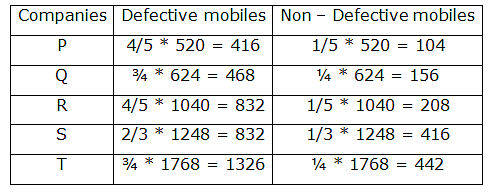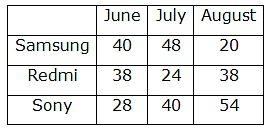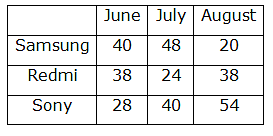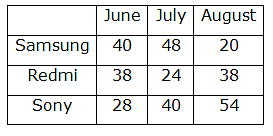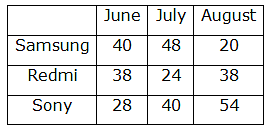Test: Quantitative Aptitude - 4 - Bank Exams MCQ
20 Questions MCQ Test IBPS PO Mock Test Series 2024 & Past Year Papers - Test: Quantitative Aptitude - 4
Directions: Study the following information carefully and answer the questions given below.
The below chart shows the percentage distribution of mobiles manufactured in five different companies.
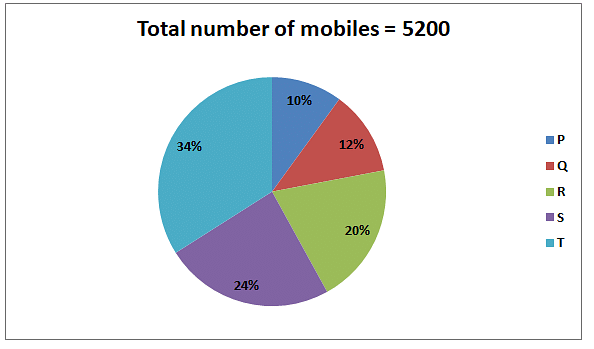
The table shows the ratio of the defective to non-defective mobiles of five different companies.

Q. Find the average number of mobiles manufactured in all the companies together.


Directions: Study the following information carefully and answer the questions given below.
The below chart shows the percentage distribution of mobiles manufactured in five different companies.

The table shows the ratio of the defective to non-defective mobiles of five different companies.

Q. Find the ratio of the number of non-defective mobiles of companies S and T together to the number of non-defective mobiles of companies P and Q together.


| 1 Crore+ students have signed up on EduRev. Have you? Download the App |
Directions: Study the following information carefully and answer the questions given below.
The below chart shows the percentage distribution of mobiles manufactured in five different companies.
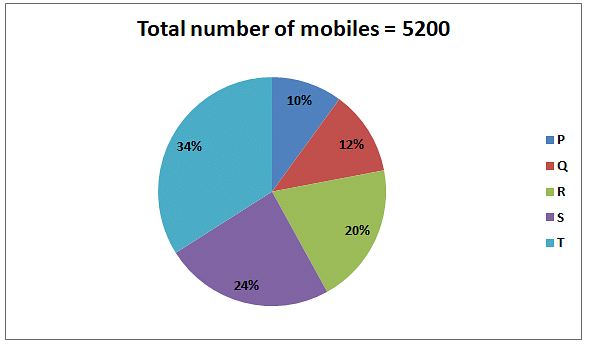
The table shows the ratio of the defective to non-defective mobiles of five different companies.

IF the ratio of the smart phones to basic phones manufactured in P and Q is 3: 1 and 2: 1 respectively, then find the difference between the number of smart phones manufactured in company P and the number of smart phones manufactured in company Q?


Directions: Study the following information carefully and answer the questions given below.
The below chart shows the percentage distribution of mobiles manufactured in five different companies.

The table shows the ratio of the defective to non-defective mobiles of five different companies.

Q. What is the difference between the number of defective mobiles of company Q and R?
Directions: Study the following information carefully and answer the questions given below.
The below chart shows the percentage distribution of mobiles manufactured in five different companies.
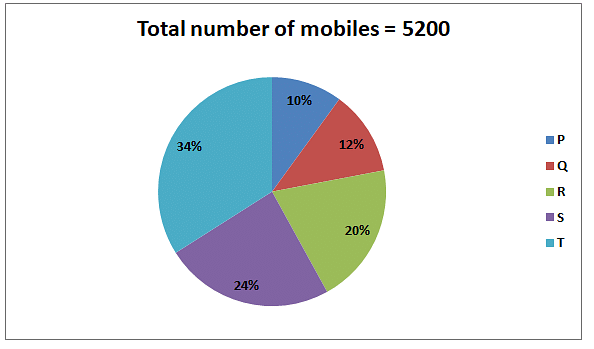
The table shows the ratio of the defective to non-defective mobiles of five different companies.

Q. The number of defective mobiles of company P is approximately what percent of the total number of mobiles manufactured in all the companies together?
Directions: Study the following information carefully and answer the questions given below.
A shopkeeper sold headsets of three companies Samsung, Redmi and Sony in 3 months June, July and August. In June month, the number of Samsung headsets sold by him is 8 less than that sold in July month. The ratio of Redmi headsets sold in July to the Sony headsets sold in August month is 4: 9. Total number of Samsung headsets sold by the shopkeeper in the three months together was 108. The ratio of Redmi headsets sold by him in July month to the Sony headsets sold by him in June is 6: 7. Total number of Sony headsets sold by the shopkeeper in the three months together is 122. Number of Sony headsets sold in August is 54. Total number of headsets sold by the shopkeeper in July month is 112. The number of Redmi headsets sold in June is equal to that in the August month which is 2 less than the Sony headsets sold in July month.
Q. What is the ratio of the number of Redmi headsets sold in June and July together to the number of Sony headsets sold in August month?
Directions: Study the following information carefully and answer the questions given below.
A shopkeeper sold headsets of three companies Samsung, Redmi and Sony in 3 months June, July and August. In June month, the number of Samsung headsets sold by him is 8 less than that sold in July month. The ratio of Redmi headsets sold in July to the Sony headsets sold in August month is 4: 9. Total number of Samsung headsets sold by the shopkeeper in the three months together was 108. The ratio of Redmi headsets sold by him in July month to the Sony headsets sold by him in June is 6: 7. Total number of Sony headsets sold by the shopkeeper in the three months together is 122. Number of Sony headsets sold in August is 54. Total number of headsets sold by the shopkeeper in July month is 112. The number of Redmi headsets sold in June is equal to that in the August month which is 2 less than the Sony headsets sold in July month.
Q. The number of Sony headsets sold by the shopkeeper in the July month is what percent of the number of Samsung headsets sold by him in the August month?
Directions: Study the following information carefully and answer the questions given below.
A shopkeeper sold headsets of three companies Samsung, Redmi and Sony in 3 months June, July and August. In June month, the number of Samsung headsets sold by him is 8 less than that sold in July month. The ratio of Redmi headsets sold in July to the Sony headsets sold in August month is 4: 9. Total number of Samsung headsets sold by the shopkeeper in the three months together was 108. The ratio of Redmi headsets sold by him in July month to the Sony headsets sold by him in June is 6: 7. Total number of Sony headsets sold by the shopkeeper in the three months together is 122. Number of Sony headsets sold in August is 54. Total number of headsets sold by the shopkeeper in July month is 112. The number of Redmi headsets sold in June is equal to that in the August month which is 2 less than the Sony headsets sold in July month.
Q. Number of Samsung headsets sold in June month and July month together is approximately how much percent more/less than the number of Sony headsets sold in July and August month together?
Directions: Study the following information carefully and answer the questions given below.
A shopkeeper sold headsets of three companies Samsung, Redmi and Sony in 3 months June, July and August. In June month, the number of Samsung headsets sold by him is 8 less than that sold in July month. The ratio of Redmi headsets sold in July to the Sony headsets sold in August month is 4: 9. Total number of Samsung headsets sold by the shopkeeper in the three months together was 108. The ratio of Redmi headsets sold by him in July month to the Sony headsets sold by him in June is 6: 7. Total number of Sony headsets sold by the shopkeeper in the three months together is 122. Number of Sony headsets sold in August is 54. Total number of headsets sold by the shopkeeper in July month is 112. The number of Redmi headsets sold in June is equal to that in the August month which is 2 less than the Sony headsets sold in July month.
Q. Find the difference between the number of headsets sold in June month to the number of headsets sold in August month.
Directions: Study the following information carefully and answer the questions given below.
A shopkeeper sold headsets of three companies Samsung, Redmi and Sony in 3 months June, July and August. In June month, the number of Samsung headsets sold by him is 8 less than that sold in July month. The ratio of Redmi headsets sold in July to the Sony headsets sold in August month is 4: 9. Total number of Samsung headsets sold by the shopkeeper in the three months together was 108. The ratio of Redmi headsets sold by him in July month to the Sony headsets sold by him in June is 6: 7. Total number of Sony headsets sold by the shopkeeper in the three months together is 122. Number of Sony headsets sold in August is 54. Total number of headsets sold by the shopkeeper in July month is 112. The number of Redmi headsets sold in June is equal to that in the August month which is 2 less than the Sony headsets sold in July month.
Q. If the price of a Redmi headset is 380 and the price of a Samsung headset is 420, then find the amount earned by the shopkeeper by selling the Redmi and Samsung headset in August month.
A box contains 36 balls of three different colors white, purple and violet and the number of purple balls is 25% less than that of the number of white balls in the box. If the probability of drawing a violet ball is 5/12, then find the probability of drawing exactly two purple balls?
A and B started the business with the investment of Rs.1440 and Rs.3600 respectively. After 4 months, A added Rs.1760 and C joined them with the investment of Rs.3240. At the end of the year, the profit share of C is what percentage of the profit share of B?
The marked price of the toaster is Rs.300 more than its cost price and the shopkeeper offers a discount of 20% on the marked price of the toaster. If he gets a profit of 12%, then find the profit earned by the shopkeeper?
Vessel A contains 62.5% of milk and the remaining 18 liters are water mixed with another vessel B contains 75 liters of a mixture of milk and water in that of 2:1 respectively. If x liters of water are added to it, then the ratio of milk and water becomes 8:5, then find the value of x?
The speed of the stream is 33.33% of the speed of the boat. If the speed of the stream is decreased by 5 kmph, then the downstream speed of the boat is 75 kmph, then find the time taken by the boat to cover 360 km upstream after decreasing the speed of the stream?
Directions: Following questions contain two equations as I and II. You have to solve both the equations and determine the relationship between them and give an answer as,
I) x2 – 3x – 40 = 0
II) y2 + 8y – 240 = 0
What approximate value should come in the place of (?) in the following questions.
839.39 - ?=√960 + 16.32 x 24.88
What approximate value should come in the place of (?) in the following questions.
8?- 14.78 x 19.99 = 29.78 x 6.8/5.2 + 170.24
Directions: Following questions contain two equations as I and II. You have to solve both the equations and determine the relationship between them and give an answer as,
I) (x – 4)2 = 81
II) y2 + 17y = - 60
What approximate value should come in the place of (?) in the following questions.
45.22% of 959.99-? = 84.32 x 24.88/21.41
|
44 docs|72 tests
|
|
44 docs|72 tests
|





